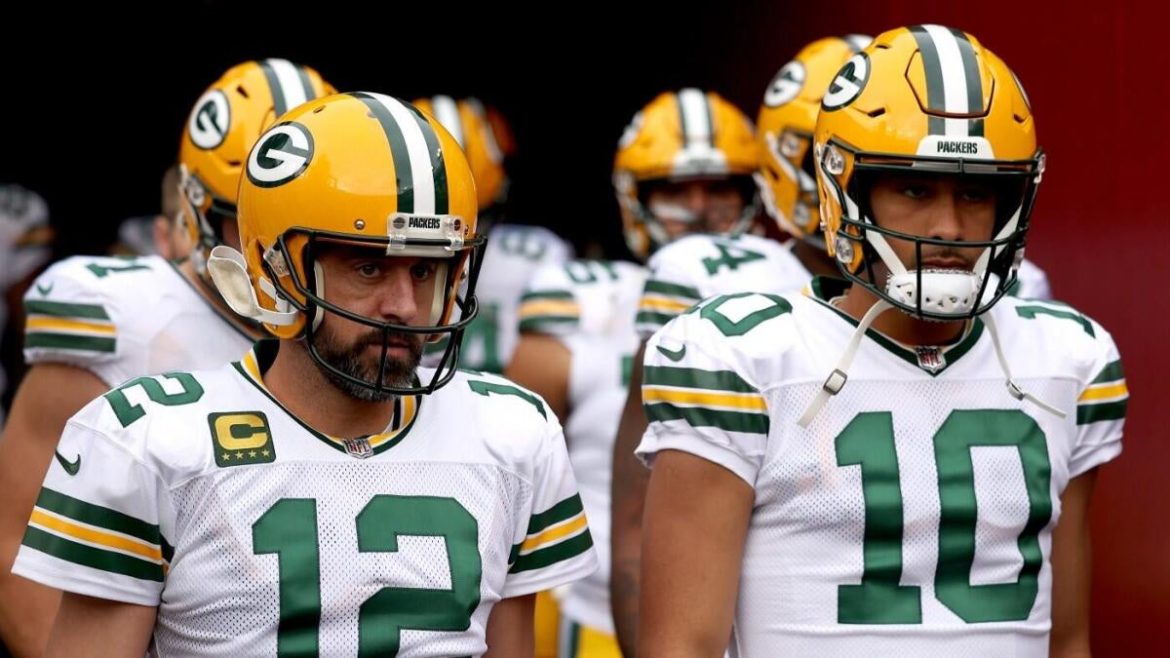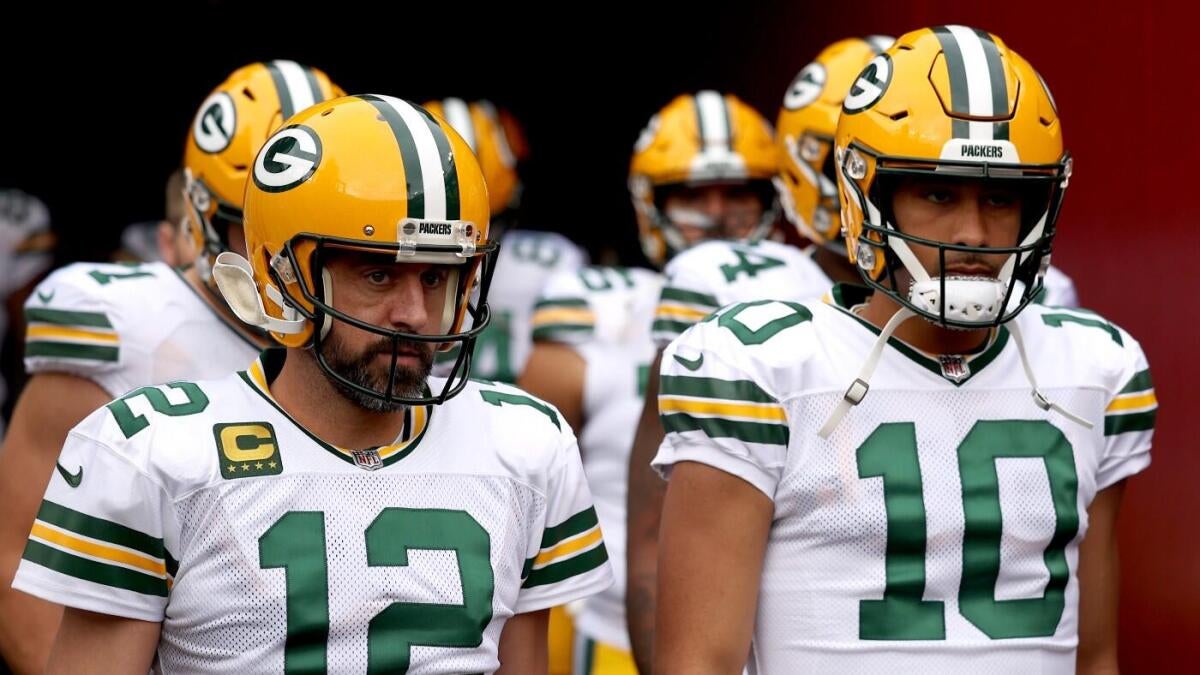The evolving saga of the Green Bay Packers’ quarterback situation, centering on Jordan Love and Aaron Rodgers, encapsulates a compelling narrative of transition, expectation, and comparison. As the 2025 NFL season unfolds, the performance and development of Jordan Love, juxtaposed with the legendary career of Aaron Rodgers, offer rich terrain for analysis that touches on statistics, leadership, team dynamics, and future prospects.
Jordan Love and Aaron Rodgers: A Statistical and Performance Comparison
One of the most striking aspects shaping conversations around the Packers’ quarterback dilemma is the statistical parallelism between Jordan Love and Aaron Rodgers during their initial NFL starts. According to several metrics, Love’s production over his first 33 starts closely mirrors Rodgers’—a detail that is both surprising and encouraging to many fans and analysts. For instance, comparisons highlight Rodgers leading with a passer rating of 103.6, with Love close behind at 95.1. Similarly, completion percentages are comparable: Rodgers at 65.3% and Love at 63.5%. These figures underscore that Love’s raw production is on a trajectory akin to Rodgers’ early career.
Yet, despite these similarities, Love’s rookie and sophomore seasons were marred by injuries and inconsistency. Critics point to performances like a recent wild card playoff game, where Love managed only 212 yards on 33 attempts, as evidence that he is not yet ready to fully inherit Rodgers’ mantle. That said, Packers’ head coach Matt LaFleur has publicly disputed critiques, emphasizing that Love’s struggles were significantly influenced by injuries, and noting the positive aspects of his play despite limited availability.
An additional point of interest is Love’s ability to shine in high-stakes games—a trait many believe had eluded Rodgers in recent years. Reports mention instances where Love’s performances have exuded the qualities of an MVP under pressure, suggesting a promising maturation curve.
Leadership and Intangibles: The Rodgers Legacy and Love’s Emergence
Aaron Rodgers’ legacy in Green Bay is not solely defined by his statistics but also by his leadership, football IQ, and clutch performances. The nature of Rodgers’ career, which included a Super Bowl win in his second playoff appearance, sets a lofty benchmark. As Love steps into the spotlight, comparisons naturally extend beyond numbers to intangible qualities.
Several Packers players and commentators have weighed in on these comparisons. Some receivers have offered bold assessments, drawing parallels between Love and Rodgers that have both excited and concerned fans, indicating the pressure Love faces to fill legendary shoes. Meanwhile, Love himself has expressed eagerness for competitive matchups, including the tantalizing prospect of facing Rodgers if he remains in the league and transitions to a different team.
Community engagement also factors into this narrative. Love’s recent public appearances, such as distributing cleats to youth sports teams, reflect his growing role as a team leader and public figure in Green Bay.
The Team’s Offensive Evolution: Adapting to Love’s Style
The transition from Rodgers to Love involves not just a change of personnel but also strategic adaptations. Coach Matt LaFleur has indicated that while the offensive system remained robust under Rodgers, there will be tweaks tailored to Love’s strengths. Emphasis on expanding the field with speedier wide receivers, including first-round draft additions, illustrates the Packers’ intent to provide Love with a versatile and dynamic supporting cast.
The offensive playcalling and execution are evolving to better suit Love’s playing style, which contrasts with Rodgers’ in key areas such as mobility, decision-making under pressure, and risk tolerance. Observers note that this adaptation period is crucial for Love’s growth and the team’s overall success.
Aaron Rodgers’ Ongoing Career and Its Impact
Rodgers’ future continues to be a subplot in this unfolding drama. Speculation about his retirement or potential final seasons with other NFL teams, such as the Jets or even a scenario reminiscent of Brett Favre’s move to rival Minnesota Vikings, fuels fan debate. Rodgers himself has expressed affection for the Packers while leaving his decision open-ended, acknowledging that his legacy transcends any single team choice.
The possibility of a Rodgers-Love showdown, especially if Rodgers suits up for a division rival like the Vikings or Steelers, adds an electrifying storyline to the 2025 season. It raises questions not only about performance but about identity, loyalty, and the cyclical nature of NFL careers.
Challenges and Expectations for Jordan Love in 2025
The 2025 season represents a pivotal moment for Jordan Love and the Packers franchise. With a tough schedule ahead and high expectations from management, fans, and analysts, Love must overcome key obstacles to solidify his place as the franchise quarterback.
Critics note that while Love’s baseline production is promising, he must improve in critical areas—completion rate, consistency under duress, and leadership—to fully capitalize on the offensive weapons at his disposal. The Packers’ recent draft strategy and player acquisitions signal a commitment to building an offense that can elevate Love’s game to the next level.
Moreover, Love’s mental resilience and capacity to handle the legacy pressure left by Rodgers will be tested. Success in 2025 could validate the franchise’s gamble on Love from the outset and set the stage for a new era of Green Bay football.
Conclusion: The Road Ahead for Green Bay’s Quarterback Transition
The narrative surrounding Jordan Love and Aaron Rodgers is emblematic of the challenges inherent in NFL quarterback succession, especially when following a Hall of Fame-caliber predecessor. Jordan Love’s statistical comparability to Rodgers in their early careers suggests a foundation of potential, but it is the intangible growth—leadership, adaptability, poise under pressure—that will ultimately define his trajectory.
The Packers’ strategic adjustments, organizational support, and Love’s personal development will determine whether he can fulfill the high expectations set forth. Meanwhile, Rodgers’ ongoing presence in the league adds an intriguing dynamic that fuels both rivalry and respect.
As the 2025 season progresses, the unfolding chapters of this quarterback saga will not only shape Green Bay’s immediate fortunes but may also serve as a blueprint for how NFL teams manage generational transitions at arguably the most critical position in football. The combination of historical resonance and contemporary performance ensures that the Packers’ quarterback story remains one of the NFL’s most fascinating narratives.





